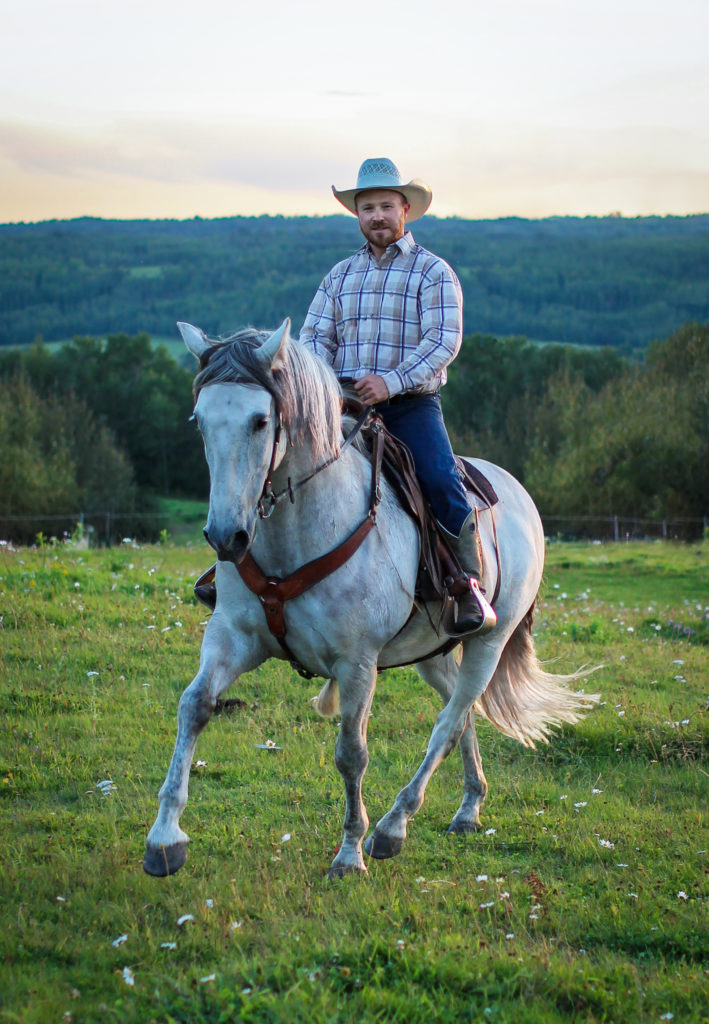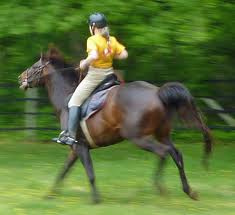I promise this is not a math lesson, but I want to start this post with an equation that can be very helpful when thinking about horses: Mind + Body = Action + Movement. Just let that float for a moment, and we’ll circle back to it soon after we break down the pieces and look at how tension factors into every part of that equation.

The dream of riding is to be one with your horse, but to accomplish this, you need to free them from mental and physical tension.
While the dream of riding is to be one with your horse, to communicate effortlessly and have the horse respond with trust and willingness, the reality is that many of us struggle with our horses day to day, and they, in turn, struggle with us. Whenever such moments arise and whatever the cause, they inevitably result in tension. Tension in the horse is a two-part problem, as it always has both a mental and a physical component. Unlike humans, who can go through the physical motions of various actions while our mind is doing something completely different, a horse cannot separate its mind from its body in this way. Therefore, if there is stress in the horse’s mind, there will be a physical manifestation of that worry, and if you stress the horse’s body, the mind will become unsettled. In almost every problem we have with our horses, including resistance to the aids, heaviness in the bridle, spooking, being herd bound, and more, you will find this duality of tension. That is the Mind + Body side of the equation

This horse has reached a tipping point and has bolted due to the tension in his mind and body. Note his inverted posture in this moment.
On the other side we have Action + Movement, action meaning what the horse does, and movement meaning how the horse uses its body during that action. The action a horse takes, whether requested by us or originating from the horse, will always be heavily influenced by what is going on in relation to Mind + Body tension, as will the way the horse moves. Here is an example of how this can play out in a negative way: A horse is worried about being away from his buddies. The tension in his mind causes tightness through his back, neck and poll, and in addition, he is unable to focus well on the rider’s aids. The rider has asked several times for the horse to bend to the inside, but the horse’s mind is being pulled to the outside, where his friends are. The horse’s poll also wants to turn to the outside, towards his buddies, and he therefore cannot bend as the rider is requesting. In frustration, the rider pulls harder on the inside rein and spurs with the inside leg. This added pressure on the body puts even more stress on the horse’s overloaded mind, and instead of bending, the horse reaches his breaking point and takes off, bolting down the rail. If you were to analyze how the horse is moving while he is bolting, you would see he is inverted (high head, dropped back, trailing hind end), and on the forehand, a posture that leaves him unable to carry either himself or the rider well and thus makes him more vulnerable to injury.
Now let’s take a look at how this equation plays out in a positive scenario: The rider has worked with the horse in a Relational context, fostering trust by meeting the horse’s needs and teaching the horse how to think through pressure and remain soft. Because the horse’s needs are consistently met by the rider, and because the horse has built up confidence in himself and in the rider, the horse’s mind is free of tension most of the time. When worries do arise, the horse believes that the rider will help him cope with it and get him back to a place of peace, and the rider does just that. As a result of the horse’s mind being consistently calm, he is able to hear every request from his rider. And, as a result of the bond and communication they have developed, he responds softly and willingly to those requests. The horse is able to maximize his athletic potential and is far more likely to remain sound, as the lack of tension in both mind and body sets him up to be able to use himself correctly, in true self-carriage. The “defensive muscles” of his topline remain relaxed, while he can easily engage the “relational muscles” of his undercarriage. He is able to rotate softly at the poll, balance his shoulders, round his back and bring his hind end well underneath himself. When the rider takes him away from his buddies, he is not concerned, but simply focuses on the task at hand, whether that be working on a half pass in the arena or working cattle out on the range.

Whether you are working in the arena or out on the range, a tension-free horse is most able to do and be what you want.
The difference between the positive and the negative here all comes down to that Mind + Body tension. But we need to recognize that a horse may not go as far as bolting or bucking or getting obviously inverted when he is experiencing tension. He may simply feel tight, stiff, or heavy in your hands. He may do his best to comply with your requests, yet he falls in or out on a circle, travels too much on the forehand, or doesn’t come under with his hind end. The point is that whether the manifestations are glaring or subtle, we can’t get where we want to be with our horses unless we “solve” the tension equation. We must therefore be continually alert to it and learn to help our horses let go of their tension, which I believe is best accomplished through thinking about the horse’s relational needs and striving to meet those needs at all times. A tension-free mind + a tension-free body = calm and responsive action + optimal movement.
Next time, we’ll take a look at how tension in the rider affects both the rider and the horse, and we’ll look at some ways to combat that tension.

Great post, totally agree with what you are saying, now I only have to get all the bits to add up. I am new to your group, but what I have already listened to and watched, will help me get there. My horse doesn’t need to change, but I do.
Yes I am having that problem can’t seem to get him away from his buddy’s. He turns on his own as I don’t like to pull on his mouth so just turn into his turn but go completely around is this the right thing to do?
I ride English and many of Josh’s techniques have helped me enjoy my horses more. A gentle, thoughtful approach to solve some pretty frustrating problems! Thank you
Hi
I have just stumbled across all this because I somehow found myself watching an old clip of you meeting your son Christopher at the airport.
I found your blog fascinating,it made me think it is very similar to the CBT that my therapist has been trying to teach me 🙂 & I understand why equine therapy is getting popular in Europe now.
I get much admire what you do and wonder why you have chosen to do this with your life!
I was also wondering how your little boy is doing- I hope you are all well.
Regards from Manchester,England.
This ties in with the wonderful Youtube presentations from the Saskatchewan Expo that I have been watching and listening to with enjoyment. I was present at those presentations and still find value in being able to now watch and listen to them. These truths you present in Relational Horsemanship can’t be stressed enough. Thank you Josh.
Boy!!! Do I know this one. It takes patience, calmness, relaxation, and confidence in the rider to help a horse through this. A tough one for me for sure. But I am excited for when it all goes together! We have had those moments. Just enough taste to keep me working on it. I know the moments will get longer. Truly a journey. Thanks Josh for all your patience with me working through all this. You have taught me all of the above, now it is my job to pass this knowledge onto my horse.